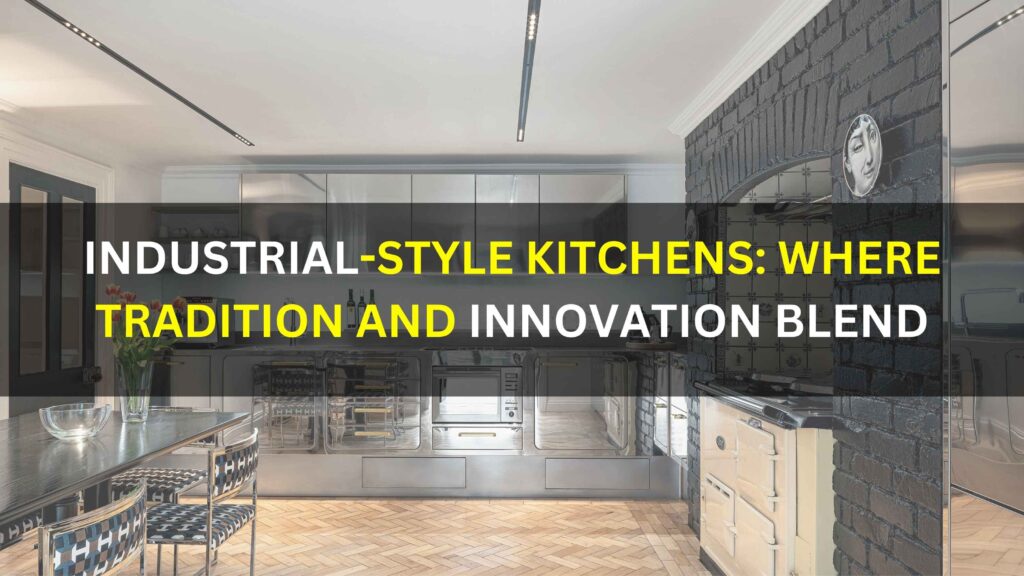The Industrial Style Kitchen: A Growing Trend in Modern Homes
Industrial-style kitchens, which originated in Northern Europe and the USA, have become increasingly popular in Italian homes as well. This style stands as a response to the minimalist trend, which often hides kitchens in the background of the home. With the rise of gourmet cooking enthusiasts, many are now opting for industrial kitchens that offer both style and high performance. These kitchens are designed not only to look functional but to deliver a premium cooking experience, making them ideal for those who enjoy showcasing their kitchen rather than concealing it.
But what exactly makes up an industrial kitchen, and how can it be best utilized in the home? Let’s explore the essential features of modern industrial kitchens and how to incorporate them into your living space.
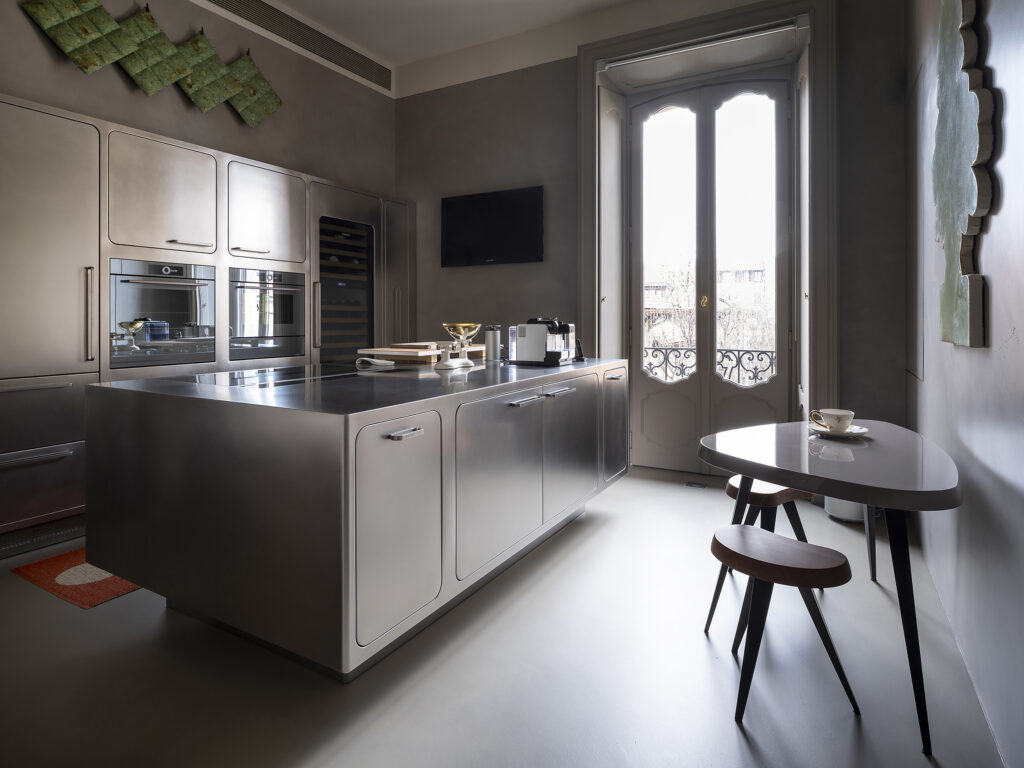
Industrial Style Cooking: Aesthetic Meets Functionality
Today’s industrial kitchens are about more than just looks—they combine aesthetics with the highest standards of functionality. These kitchens must not only deliver exceptional performance in terms of ergonomics and usability but also be equipped for serious cooking. The ideal industrial kitchen isn’t just a beautiful vintage-style space; it should function like a professional cooking environment, offering the best equipment and design for everyday use.
For those seeking a true “semi-professional” kitchen at home, the industrial-inspired kitchen is the perfect blend of style and function. It’s not just a visual statement; it’s built to be a high-performing space for culinary enthusiasts.
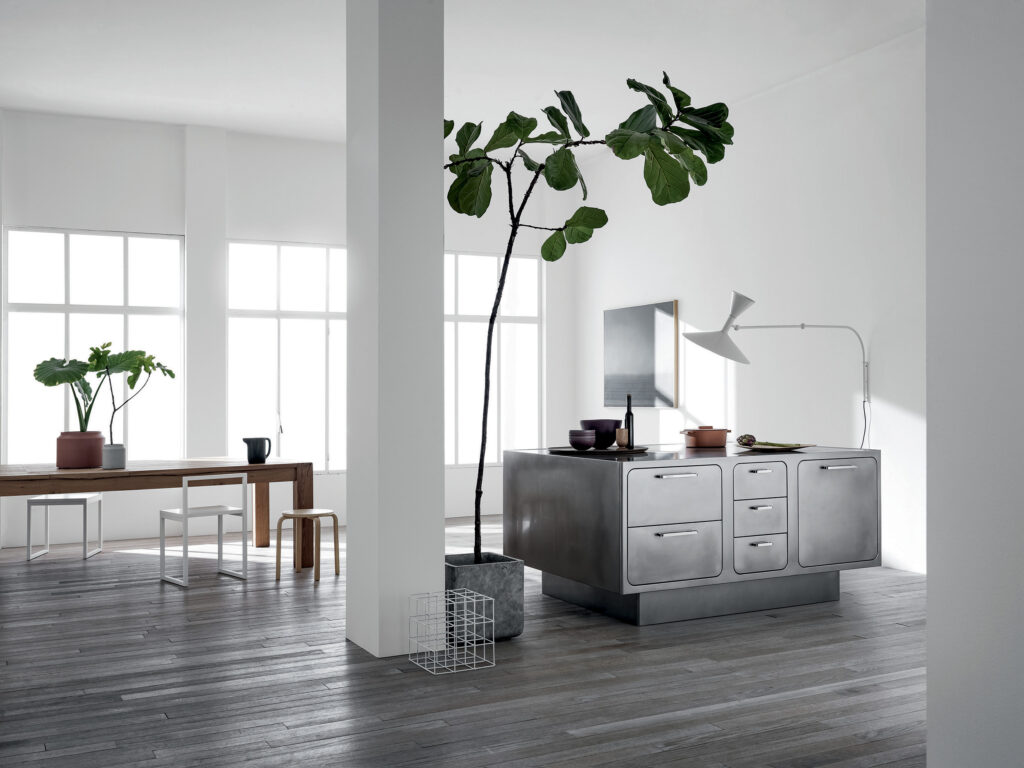
Tips for Choosing an Industrial Style Kitchen
1. The Industrial Kitchen? Better “On View”!
Unlike the trend of kitchens that blend seamlessly into the rest of the home, industrial kitchens are meant to stand out and be admired. These kitchens are designed to be showcased, and the ideal layout often includes a central island that becomes the focal point of the space. This layout mimics old professional kitchens and puts the kitchen front and center in your home. For a similar effect, linear or corner kitchen designs can also create a striking impression, with careful attention to the choice of materials and colors for the back wall.
2. The Materials and Finishes of Industrial Kitchens
Stainless steel is the standout material for industrial kitchens, widely used for its durability and sleek appearance. However, it is often paired with other materials such as natural stone for countertops or brass, bronze, and copper for accents. This combination of materials creates a harmonious balance between the practical and the aesthetic. Key details such as the stove, hood, taps, and handles should be chosen carefully to enhance the overall industrial vibe. Additionally, consider mixing open shelves or étagères with closed cabinets to achieve that authentic restaurant-kitchen effect.
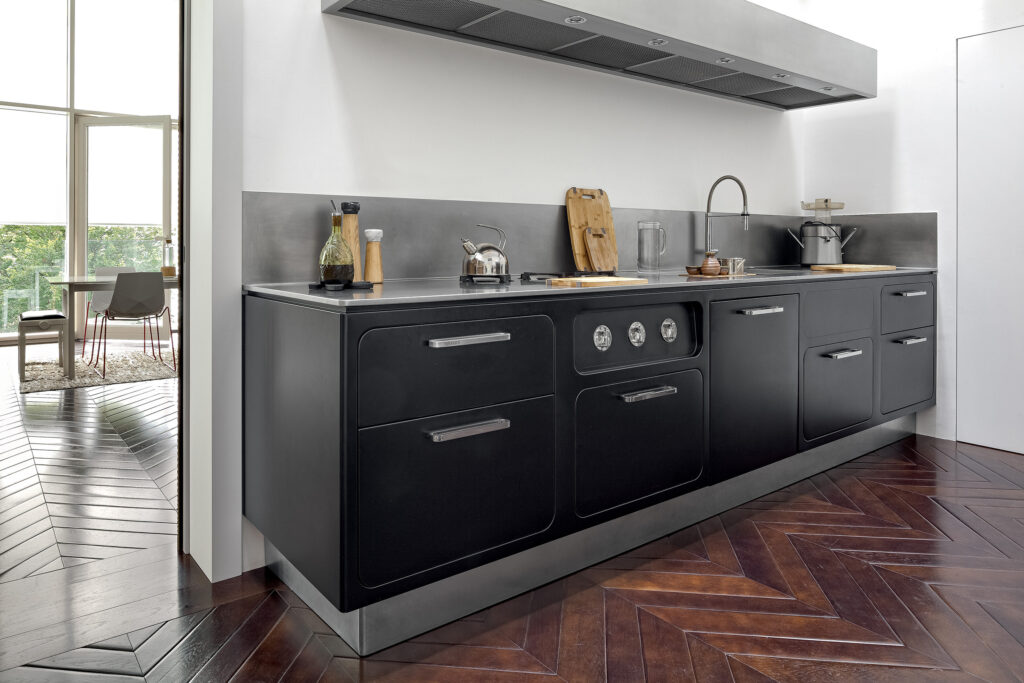
3. The Colors and Finishes of Industrial Kitchens
Stainless steel is the most iconic material, but it can be combined with bold, eye-catching colors to make the kitchen pop. Think pumpkin orange, dark blue, sage green, or even black for a striking effect. Steel handles in polished brass or antique bronze can further emphasize the industrial aesthetic. Stainless steel itself can come in different finishes, such as satin, hand-orbited, or mirror-polished, which help reflect light and make the space feel more expansive and bright. And contrary to common belief, stainless steel is relatively easy to maintain and clean.
4. And the Colors to Choose for the Walls!
For industrial kitchens, dark colors for the walls work best. Shades like grey, earth tones, blue, and green contrast beautifully with the shiny steel surfaces, making the kitchen feel both modern and inviting. If you live in an older property, exposed brick or stone walls can add even more character and authenticity to the industrial look. Alternatively, you can opt for rough concrete, vintage-style tiles, or steel-clad walls to complete the theme.
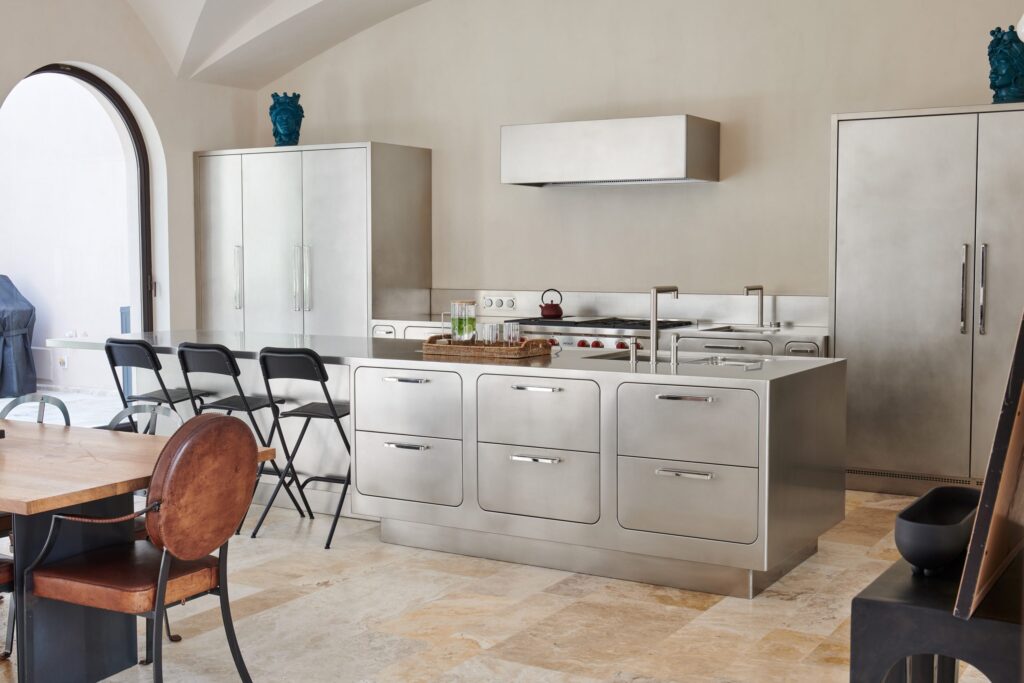
Industrial-Style Kitchen Lighting
Lighting plays an essential role in industrial kitchen design, serving both functional and aesthetic purposes. In addition to providing necessary task lighting over work areas, industrial kitchens should incorporate mood lighting that highlights the kitchen’s details even in low light. Consider installing LED strips under the cabinets or in the skirting board to subtly illuminate the kitchen and draw attention to its features. Spotlights or task lighting can be strategically placed to accentuate key elements, while careful planning is needed to avoid harsh reflections, especially when dealing with stainless steel surfaces.
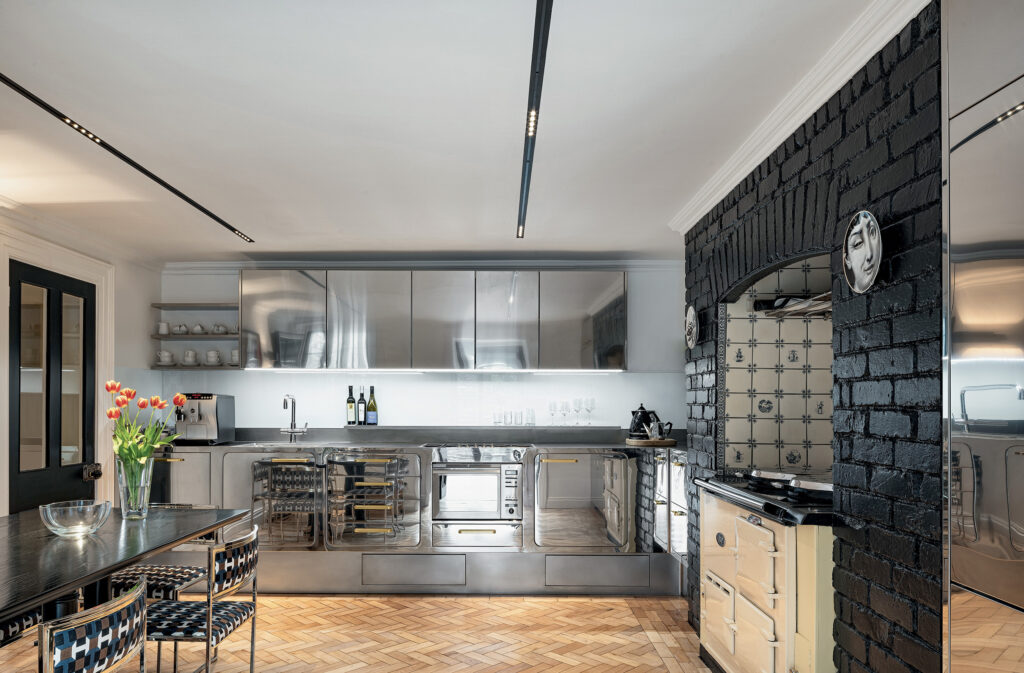
Abime’s Industrial Style Kitchens
Abime’s specializes in high-performance, professional stainless steel kitchens that are perfect for both residential and commercial use. Their kitchens are designed with style and functionality in mind, offering custom-made solutions that can be tailored to the homeowner’s specific needs and preferences.
Abime’s offers three main models: the Ego, with rounded lines inspired by the ’50s and ’60s; the Atelier, which features the classic clean lines of professional kitchens; and the Atria collection, designed for those who enjoy the industrial style even in outdoor kitchens.
Whether you’re a designer, interior decorator, or homeowner, Abime’s kitchens are ideal for those looking to bring an industrial-style kitchen to life in any space, from contemporary lofts to classic, rustic homes.
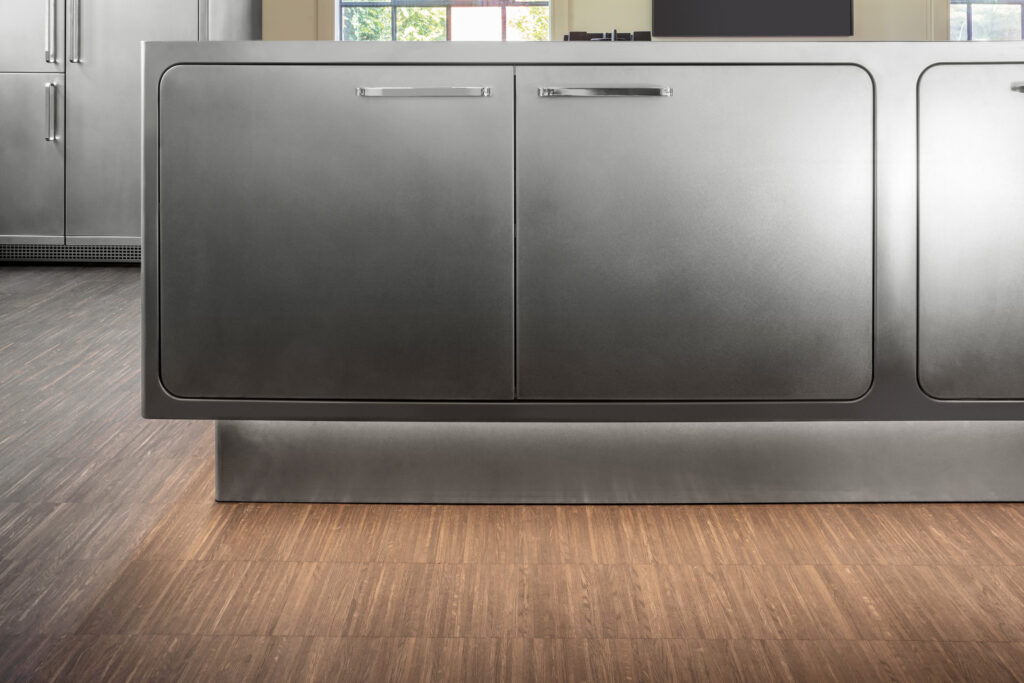
FAQs
1. What makes industrial-style kitchens so popular?
Industrial-style kitchens are popular due to their bold and functional design, which contrasts the minimalist trend. They appeal to homeowners and gourmet cooking enthusiasts who prefer kitchens that are both aesthetically pleasing and high-performance. The style is also increasingly chosen for its vintage charm and the ability to showcase personality, especially in homes where the kitchen becomes a focal point.
2. How can I make my kitchen fit into the industrial style?
To achieve an industrial-style kitchen, focus on key elements such as stainless steel materials, open shelving, and the use of natural stones or alloys like brass, bronze, or copper. Incorporate functional, vintage-inspired details such as traditional gas hobs, industrial lighting, and visible kitchen tools to create a kitchen that both looks great and works efficiently.
3. What colors work best in an industrial-style kitchen?
Industrial kitchens often feature dark color palettes for the walls, such as grey, ochre, brown, blue, or even black. These colors contrast beautifully with the bright shine of stainless steel. You can also experiment with bold colors like pumpkin orange, sage green, or warm yellow for accents. The kitchen’s finishes may vary from satin, hand-orbited, to polished stainless steel, each adding a distinct look.
4. What type of lighting should I choose for an industrial kitchen?
Lighting is crucial in an industrial kitchen, both for functionality and aesthetic appeal. In addition to standard task lighting, mood lighting is essential to highlight the kitchen’s details. Consider using spotlights or integrated LED strips hidden in the kitchen’s structure, such as under cabinets or along the skirting board. Proper lighting enhances the kitchen’s reflective surfaces, especially stainless steel, without creating harsh reflections.
5. What are some top brands for industrial-style kitchens?
Abime’s is a leading brand offering high-performance industrial-style kitchens made of stainless steel. Their kitchens are custom-made and designed for home use, inspired by professional kitchens. Abimis offers different models like the Ego, Atelier, and Àtria collections, each catering to various design preferences, from vintage to contemporary, and even outdoor kitchens.

